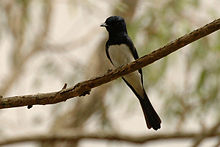Satin flycatcher
This article needs additional citations for verification. (August 2021) |
| Satin flycatcher | |
|---|---|

| |
| Scientific classification | |
| Kingdom: | Animalia |
| Phylum: | Chordata |
| Class: | Aves |
| Order: | Passeriformes |
| Family: | Monarchidae |
| Genus: | Myiagra |
| Species: | M. cyanoleuca
|
| Binomial name | |
| Myiagra cyanoleuca (Vieillot, 1818)
| |
| Synonyms | |
| |
The satin flycatcher (Myiagra cyanoleuca) is a species of bird in the family Monarchidae. It is a small bird that stands out because it is mostly black. It breeds mostly in south-eastern Tasmania and Australia. It is declining throughout the eastern seaboard due to predation from the introduced Red Fox and habitat loss. It is a vagrant to New Zealand.
Taxonomy and systematics[]
The satin flycatcher was originally described in the genus Platyrhynchos. Alternate names include satin Myiagra and satin Myiagra-flycatcher.
Distribution[]
The satin flycatcher is found in Australia, Indonesia, and Papua New Guinea. Its natural habitats are temperate forests and subtropical or tropical moist lowland forests, and it even visits suburban gardens. It is a vagrant to New Zealand, with only a few records.
Description[]
Males are dark grey on their beak, eyes, legs and upper body with a white lower body. Females differ from males by having a more grayish upper body and light orange around their throat.
Breeding[]
The satin flycatcher breeds from October - February. 2 or 3 greenish blue with brown spotted eggs will be laid in a neat nest made of bark, spider's web and moss on a branch 5 – 25 m high.
References[]
- ^ BirdLife International (2017). "Myiagra cyanoleuca". IUCN Red List of Threatened Species. 2017: e.T22707403A118760627. doi:10.2305/IUCN.UK.2017-3.RLTS.T22707403A118760627.en. Retrieved 14 November 2021.
- Satin Flycatcher. arthurgrosset.com
- IUCN Red List least concern species
- Myiagra
- Birds of New South Wales
- Birds of South Australia
- Birds of Tasmania
- Birds of Victoria (Australia)
- Birds described in 1818
- Monarchidae stubs
